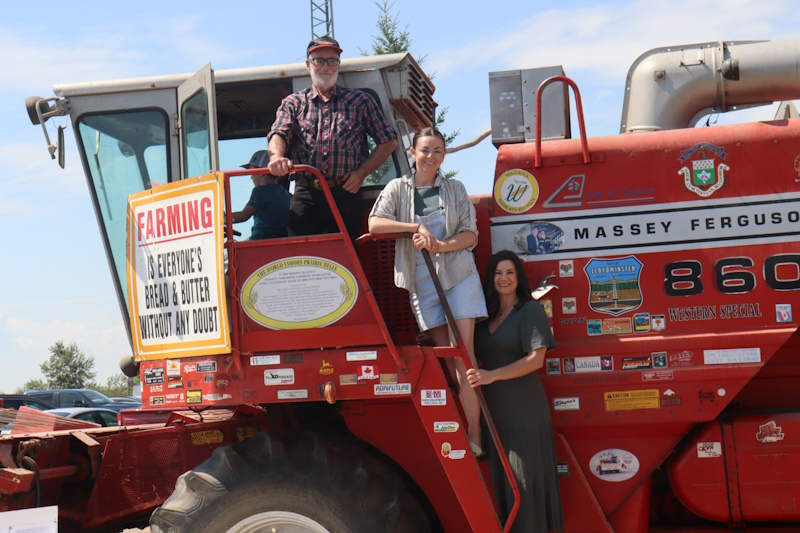Wadena’s Vintage Day had a bonus this year with a special guest in attendance and a reunion with a special and historical piece of farming equipment.
A great crowd made its way south on Highway 35 in Wadena to the Wadena Museum grounds for displays, demonstrations, music and memories. The iconic train station, moved from its original trackside location in Wadena is the most noticeable feature in a restored village display on the grounds.
Donna Zarowny is the curator of the Wadena Museum; she gives an overview of the grounds and all they house.
“We have 12 buildings and 2 machine sheds with hordes of machinery outside for people to look at,” Zarowny pointed out. “With the buildings, we have the North West Mounted Police outpost, a school from the late 1800’s, a teacherage, the station house built in 1904, the 1912 Anglican Church, the store from the 1930s or 40s, and a Russian banya which is a combination woodstove and steam bath utilized by the Dukhobor community.
The Anglican church, which was brought in from nearby Margo was never decommissioned, so a special blessing was given by the Bishop to allow its continued engagement as an Anglican place of worship, explained Louise Yakowec, Zarowny’s predecessor as curator.
The museum sits on the former Brice family farm which was sold to the town for the purpose of developing a museum site.
“The Brice family gave us the original farmhouse,” said Yakowec. “That is an historical house as it’s a catalog house, shipped by train.”
During the noon hour, the guest of honour arrived. Nick Parsons, the farmer who made the famous combine trek from Dawson Creek to Ottawa in 2000 in support of family farms arrived. Sitting in the centre of the compound was the 1978 Massey Ferguson combine, the Prairie Belle.
A smile lit up Parsons’ face as he approached the machine which was donated to the museum in appreciation of the support from Saskatchewan farmers. He took immediate delight in the condition of the machine.
“I can’t believe there’s not more rust,” Parsons first observed. “There was just a bit of rust 15 years ago when I last saw her. I’m so pleased its being looked after.” The combine has been housed in the ventilated and climate-controlled storage quonset and not left outside to the elements where it would have otherwise deteriorated. Even a personal memento Nick tucked onto the combine remained.
“I put a sheaf of wheat on the side of the combine,” he noted. “The sheaf is still there, but the grain is gone – I noted that first. It’s just as it was.”
One of the most obvious features speckling the Massey red paint job was the proliferation of stickers bearing the names of towns and locales. Like a steamer trunk that's lapped the world a couple of times, the decals are a testament to the zig-zag route Nick took on his journey. He made an effort to go to places that reached out to him during the trip, even those well off his route, to communicate with area farmers. Wherever he went, he was always met with an outpouring of hospitality, encouragement and heartfelt thanks for his undertaking.
“I had forgotten there were so many,” he said, memories welling up within him. “It turned into something I didn’t imagine.”
He remains humble about the trip and what ensued following, but Parsons recognizes that those efforts were the precursor to many of the support platforms and programs that remain in place today in the ag sector. While not directly involved in the planning, Parsons shared his stories with those on Parliament Hill who were in positions to lean into government policy and take heed of the concerns of Canada’s farmers.
Nick Parsons was accompanied by his daughters on his visit to Wadena. Both Emily and Catherine had been knowledgeable operators on Prairie Belle in her heyday on their 1,200 acre farmer near Dawson Creek. The two were both emotional at seeing the harvester they’d spent many hours working.
“It feels very nostalgic,” Emily admitted with a smile, “But it also feels like I could get on her right now, start it up and away we go. Muscle memory makes you know exactly what to do.”
Catherine experienced a swell of emotion both for her dad’s experience and being in the presence of the Prairie Belle, an important part of their lives.
“It’s a big part of our history as a family, and seeing her in such great condition – the museum here has done such an amazing job. Looking back at everything my dad went through at all the support he had, especially from the Saskatchewan and Manitoba farmers.”
There was more than one family that took delight with the reunion and seeing the threshing and rope making demonstrations, the interior of the store and the school house, and the Percheron horse hook that gave cart rides, courtesy of Lloyd Smith of Pelly. Memories abounded in Wadena with the hard work of the volunteers at Vintage Day.
